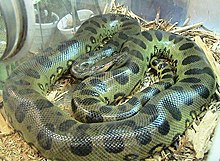User:Dorkstar17/Infoboxes
| Eunectes | |
|---|---|

| |
| Green anaconda, E. murinus | |
| Scientific classification | |
| Kingdom: | |
| Phylum: | |
| Subphylum: | |
| Class: | |
| Order: | |
| Suborder: | |
| Family: | |
| Subfamily: | |
| Genus: | Eunectes Wagler, 1830
|
| Synonyms | |
| |
Eunectes is a genus of non-venomous boas found in tropical South America, commonly called anacondas. An aquatic group of snakes inhabiting swamps and rivers, its members include some of the largest snakes in the world. Despite this, little was known about them until recently. The name Eunectes is derived from the Greek word Eυνήκτης, which means "good swimmer." Three species are currently recognized.[2]
Description
[edit]There are some debates about the maximum size of these snakes. Mehrtens (1987) states that the average adult length for the green anaconda, E. murinus, is 18 to 20 feet (5.5–6.1 m), with 25 feet (7.6 m) specimens being very rare. He sets a more conservative maximum at 23 feet (7.0 m). Estimates of 35 to 40 feet (11–12 m) (see Giant anaconda) are based on vague data and should be regarded with caution.[3] In a study of 1,000 specimens captured in Venezuela, the largest was 17 feet (5.2 m) long and weighed 100 pounds (45 kg).[4]
The Wildlife Conservation Society has, since the early 20th century, offered a large cash reward (currently worth US$50,000) for live delivery of any snake of 30 feet (9.1 m) or more in length. This prize has never been claimed.[5] In any case, measuring a snake that is stronger than a person is not an easy task. It was found that two scientists independently measuring the same 12-foot (3.7 m) plus snake showed a variation of more than 20% in their results.[6]
Common names
[edit]Local names in South America include the Spanish term "matatoro," meaning "bull killer," and the Native American terms sucuri and "yakumama."
A possible origin for the common name anaconda is the Tamil anaikondran, meaning "elephant killer", or anaikkonda, meaning "having killed an elephant". A name first used in English to name a Ceylonese python, it erroneously was applied to a large South American boa, called in Brazil "sucuri". The word is of uncertain origin, and no snake name like it now is found in Sinhalese or Tamil. Another suggestion is that it represents Tamil. It is unclear how this name originated so far from the snake's native habitat; possibly this is due to its vague similarity to the large Asian pythons.
Geographic range
[edit]Found in tropical South America from Colombia and Venezuela south to Argentina.[1]
Reproduction
[edit]This section needs expansion. You can help by adding to it. (August 2008) |
Ovoviviparous, with females giving birth to live young.
Captivity
[edit]There have been very few instances of this species being bred in captivity. In October 2007, the New England Aquarium in Boston achieved a breakthrough when it was discovered that one of their females was gravid. Fourteen young were born on January 1, 2008.
Species
[edit]| Species[2] | Taxon author[2] | Subsp.*[2] | Common name | Geographic range[1] |
|---|---|---|---|---|
| E. deschauenseei | Dunn & Conant, 1936 | 0 | Dark-spotted anaconda | South America in northeastern Brazil and coastal French Guiana. |
| E. murinusT | (Linnaeus, 1758) | 1 | Green anaconda | South America in countries east of the Andes, including Colombia, Venezuela, the Guianas, Ecuador, Peru, Bolivia, Brazil and on the island of Trinidad. |
| E. notaeus | Cope, 1862 | 0 | Yellow anaconda | South America in eastern Bolivia, southern Brazil, Paraguay and northeastern Argentina. In Argentina it is found in the provinces of Corrientes, Chaco, Entre Rios, Formosa, Misiones and Santa Fe. |
*) Not including the nominate subspecies.
T) Type species.[1]
See also
[edit]References
[edit]- ^ a b c d McDiarmid RW, Campbell JA, Touré T. 1999. Snake Species of the World: A Taxonomic and Geographic Reference, vol. 1. Herpetologists' League. 511 pp. ISBN 1-893777-00-6 (series). ISBN 1-893777-01-4 (volume).
- ^ a b c d "Eunectes". Integrated Taxonomic Information System. 18 July.
{{cite web}}: Check date values in:|date=and|year=/|date=mismatch (help) - ^ Mehrtens JM. 1987. Living Snakes of the World in Color. New York: Sterling Publishers. 480 pp. ISBN 0-8069-6460-X.
- ^ The Search for the $50,000 Snake at MSN Encarta. Accessed 18 July 2008.
- ^ Splendor in the Mud: Unraveling the Lives of Anacondas by Carol Kaesuk Yoon, April 2 1996, at New York Times. Accessed 18 July 2008.
- ^ Rivas JA, Ascanio RE, Muñoz MDC. 2008. What is the length of a snake? Comtemporary Herpetology, Vol. 2008(2):1-3. PDF at Comtemporary Herpetology. Accessed 18 July 2008.
External links
[edit]- Eunectes at the Reptarium.cz Reptile Database. Accessed 18 July 2008.
- Life history and conservation of the green anaconda (Eunectes murinus) at Anacondas.org. Accessed 18 July 2008.
